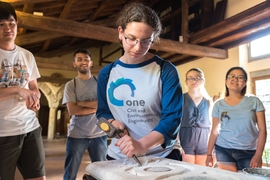From transportation systems and sustainable infrastructure to climate variability and atmospheric pollution, there was no lack of diversity in the research showcased at the Department of Civil and Environmental Engineering (CEE) Research Night, a fun and casual networking event for CEE community members on April 24.
Although many students and researchers travel around the world to share their research findings at conferences and lecture series, the CEE Research Night was created as a forum for the community to learn about the wide range of research conducted in the department and areas for future developments.
“It was great to see the whole community come together to learn from one another, as well as to support and encourage each other at the CEE Research Night,” says Markus Buehler, the McAfee Professor of Engineering and department head. “It is our hope that through community events like this one, our students, faculty, and researchers will establish relationships and connections with people who they might not see regularly, but who could greatly benefit from each other’s research interests or methods at the interfaces of disciplines.”
Over 30 participants spoke about their work during an electronic poster session and networked with peers and faculty who came to hear about the research. Posters represented the wide range of research conducted across the department and the important problems CEE students are seeking to solve.
Presenter Reetik Sahu is a graduate student in Professor Dennis McLaughlin’s research group. He presented a poster on “Managing the groundwater as a common pool dynamic competition,” which balanced the intersection of economic decision-making and the demands of farmers competing for the same water, with the known environmental research on hydrology and groundwater resources.
Using data from San Joaquin, California, Sahu created a model that considers “competitive economic decision making,” while factoring in the environmental feasibility of putting demands on these resources.
“[CEE Research Night] is a platform for me to share my research with others in the department and in the community and, at the same time, to get broader feedback on my project to see if it is really relevant to people who are not familiar with my [research] problems,” Sahu said at the event.
Other posters, such as graduate student Li Jin’s “Resilient Control of Smart Highways,” considered the future of transportation systems and smart cities. A graduate student in Professor Saurabh Amin’s Resilient Infrastructure Networks Lab, Jin works on resilient operations and smart transportation systems. His work considers the implications of embedding computer technology into transportation. The conditions he considers range from the “nominal,” or expected setting; a scenario with “random perturbations” that may arise; as well with scenarios with security failures.
Jin’s poster covered two case studies that modeled instances of smart highways. One example was of “vehicle platoons,” or trains of trucks on the highway that are not physically connected but maintain contact through communications. These platoons allow more efficient operations, which could result in fuel savings and more streamlined traffic flows by managing the distance between vehicles. The other example identified the potential bottlenecks and congestion that may arise in existing infrastructure with smart highway technology, such as vehicle platoons traveling as moving bottlenecks for the background traffic. This helps traffic managers identify the tradeoffs of smart highways in order to help them deploy optimal solutions, Jin explained.
“I think [CEE Research Night] is a very good opportunity to present my research to other people and ask for their feedback and see if there is anything that I can improve,” Jin said at the event. “It’s also a good chance to do some brainstorming and to walk around and see what other people are doing and to get some new ideas.”
Jane Chui, a graduate student in Ruben Juanes’ research group, presented a poster on her work which considers the physics of fluid viscous materials underground, such as oil. Chui is seeking to understand how active, living organisms like bacteria could potentially change the nature of these fluid flows, as bacteria interaction could change the viscosity of the surrounding environment and ultimately help with applications like microbial enhanced oil recovery.
“Viscous fingering is something that’s been studied by the oil industry for a very long time, but I want to expand this to other applications like the bioremediation of subsurface spills,” Chui said. “I wanted to present my research [at CEE Research Night] because I think a lot of people think of viscous fingering as an old problem, but this is a new and exciting development and a branch off of the classical problem that’s picking up now.”
Sahu, Jin, and Chui provide just a sample of the diverse and wide-ranging research represented at the event. The multitude of poster presentations and were judged by attendees, including CEE faculty, who evaluated the clarity and impact of the research, as well as participants’ presentation skills.
At the conclusion of the night, three top prizes, determined by students and faculty at the event, were awarded to graduate student Murat Uzun for “Learning Full-scale structures;” Chui for “Impact of motile bacteria on viscous fingering;” and postdoc Diego Lopez Barreiro for “Multiscale modeling and manufacture of biomass-derived materials.”
“In a conference setting, the audience is composed of researchers with a similar background. In CEE Research Night type of events, however, you really need to identify and convey the key aspects of your research. I found this information condensation and filtering helpful for my thinking process,” Uzun said after the event. “Here in MIT CEE, we have a very multidisciplinary culture with people from various backgrounds. Different perspectives can be really beneficial.”











